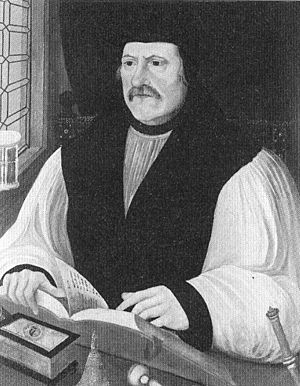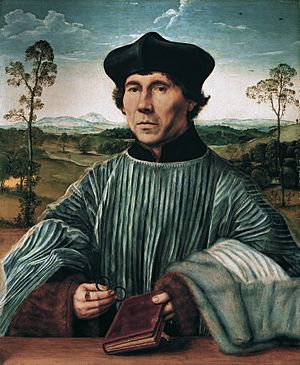Gilbert Bourne facts for kids
Quick facts for kids The Right Reverend Gilbert Bourne |
|
|---|---|
| Bishop of Bath and Wells | |
| Church | Church of England/Roman Catholic |
| Diocese | Diocese of Bath and Wells |
| See | Diocese of Bath and Wells |
| In Office | 1554–1559 |
| Predecessor | William Barlow |
| Successor | Gilbert Berkeley |
| Personal details | |
| Died | 10 September 1569 Silverton, Devon |
| Previous post | Archdeacon of Bedford |
Gilbert Bourne (born in an unknown year, died September 10, 1569) was an important religious leader in England. He was the last Roman Catholic Bishop of Bath and Wells. This means he was a high-ranking church official who followed the Pope in Rome. His life was during a time of big changes in England's religion. These changes involved the shift between the Roman Catholic Church and the new Church of England.
Gilbert Bourne's Early Life and Career
Gilbert Bourne was the son of Philip Bourne from Worcestershire, England. He began his studies at the University of Oxford in 1524. By 1531, he became a Fellow at All Souls College. He earned his degree in Arts in 1532. Later, in 1543, he received a degree in Divinity.
In 1541, Bourne became a prebendary of Worcester. A prebendary is a type of church official. This happened after the old monastery there was closed down. In 1545, he moved to London. He became a prebendary at St Paul's Cathedral. By 1549, he was made Archdeacon of Bedford. An archdeacon is another senior church position. He also became the rector of High Ongar in Essex.
During this time, England's religion was changing. Under King Henry VIII and his son Edward VI, the Church of England was established. Holding these church jobs meant accepting the new church.
When Queen Mary became queen, she wanted to bring back the Roman Catholic faith. Bourne was preaching at St Paul's Cross in London. A fanatic attacked him there. He was pulled from the pulpit and nearly hit by a dagger.
In 1554, Bourne was appointed Bishop of Bath and Wells. He received forgiveness from Cardinal Reginald Pole. This was for any actions he took during the time of religious division. On April 1, 1554, he was consecrated as a bishop. Bishop Bonner, Bishop Stephen Gardiner, and Bishop Cuthbert Tunstall helped with the ceremony.
During his time as bishop, Bourne was known for his kindness. He did not take part in the Marian Persecutions. These were harsh actions against Protestants. Instead, he used gentle methods. There are no records of religious executions in his area. Queen Mary thought highly of him. She made him Lord President of the Council of Wales. This was an important government role.
Challenges Under Queen Elizabeth I
When Queen Elizabeth became queen, things changed again. She wanted to restore the Church of England. At first, Bourne was not in London. He was ill and busy with other duties. He was one of the last bishops to be removed from his position. He was even asked to help consecrate Matthew Parker. Parker was chosen to be the new head of the queen's church.
Queen Elizabeth was happy with Bourne's service. However, he refused to take the Oath of Supremacy. This oath would have recognized the queen as the head of the church. Because he refused, he was removed from his office. This happened on October 18, 1559.

For a few months, Bourne stayed in Somerset. He was like a prisoner on parole. But on May 31, 1560, he was called to London. He knew what to expect. On June 18, he was sent to the Tower of London. He was held as a close prisoner. Five other bishops were already there. He stayed in the Tower for three years. For most of that time, he was kept alone.
In September 1563, there was an outbreak of the plague. Bourne and the other bishops were moved. They were placed in the care of some Anglican bishops. Bourne was apparently sent to Bishop Nicholas Bullingham of Lincoln.
This began a period of constant moving for the deposed bishops. They were shifted from one keeper to another. They also moved from one prison to another. William Allen described this as part of their "martyrdom." In June 1565, the Council sent them back to the Tower. Later, they were still referred to as being in public prisons.
After nearly ten years of this, Bishop Bourne died. He passed away at Silverton in Devon. He had been placed in the care of George Carew. Carew was the Archdeacon of Exeter. Bourne was buried in the church there.
He is remembered as one of the "Eleven Bishops." A picture of their imprisonment was allowed by Pope Gregory XIII. It was placed in the English College church in Rome. It was among pictures of English Saints and Martyrs. An inscription said they "died for their confession of the Roman See and Catholic faith." It also said they were "worn out by the miseries of their long imprisonment."


